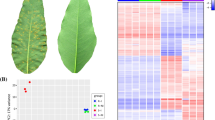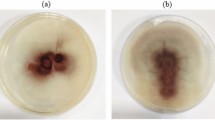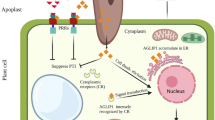Abstract
Downy mildew, caused by the oomycete Plasmopara viticola, is a serious fungal disease in the cultivated European grapevines (Vitis vinifera L.). The class 10 of pathogenesis-related (PR) genes in grapevine leaves was reported to be accumulated at mRNA level in response to P. viticola infection. To elucidate the functional roles of PR10 genes during plant–pathogen interactions, a PR10 gene from a fungal-resistant accession of Chinese wild Vitis pseudoreticulata (designated VpPR10.2) was isolated and showed high homology to PR10.2 from susceptible V. vinifera (designated VvPR10.2). Comparative analysis displayed that there were significant differences in the patterns of gene expression between the PR10 genes from the two host species. VpPR10.2 was induced with high level in leaves infected by P. viticola, while VvPR10.2 showed a low response to this inoculation. Recombinant VpPR10.2 protein showed DNase activity against host genomic DNA and RNase activity against yeast total RNA in vitro. Meanwhile, recombinant VpPR10.2 protein inhibited the growth of tobacco fungus Alternaria alternata and over-expression of VpPR10.2 in susceptible V. vinifera enhanced the host resistance to P. viticola. The results from subcellular localization analysis showed that VpPR10.2 proteins were distributed dynamically inside or outside of host cell. Moreover, they were found in haustorium of P. viticola and nucleus of host cell which was associated with a nucleus collapse at 10 days post-inoculation. Taken together, these results suggested that VpPR10.2 might play an important role in host plant defense against P. viticola infection.






Similar content being viewed by others
Abbreviations
- PR:
-
Pathogenesis-related
- VpPR10.2 :
-
Vitis pseudoreticulata PR10.2
- qRT-PCR:
-
Quantitative reverse transcription polymerase chain reaction
- EST:
-
Expressed sequence tag
- GST:
-
Glutathione-S-transferase
- IPTG:
-
Isopropyl-beta-d-thiogalactopyranoside
- hpi:
-
Hours post-inoculation
- dpi:
-
Days post-inoculation
References
Arnoys EJ, Wang JL (2007) Dual localization: proteins in extracellular and intracellular compartments. Acta Histochem 109(2):89–110
Bellin D, Peressotti E, Merdinoglu D, Wiedemann-Merdinoglu S, Adam-Blondon A-F, Cipriani G, Morgante M, Testolin R, Di Gaspero G (2009) Resistance to Plasmopara viticola in grapevine ‘Bianca’ is controlled by a major dominant gene causing localised necrosis at the infection site. TAG Theor Appl Genet 120(1):163–176
Borie B, Jeandet P, Parize A, Bessis R, Adrian M (2004) Resveratrol and stilbene synthase mRNA production in grapevine leaves treated with biotic and abiotic phytoalexin elicitors. Am J Enol Vitic 55(1):60–64
Cadle-Davidson L (2008) Variation within and between Vitis spp. for foliar resistance to the downy mildew pathogen Plasmopara viticola. Plant Dis 92(11):1577–1584
Castro AJ, Carapito C, Zorn N, Magne C, Leize E, Van Dorsselaer A, Clement C (2005) Proteomic analysis of grapevine (Vitis vinifera L.) tissues subjected to herbicide stress. J Exp Bot 56(421):2783–2795
Chadha P, Das R (2006) A pathogenesis related protein, AhPR10 from peanut: an insight of its mode of antifungal activity. Planta 225:213–222
Chang MM, Chiang CC, Martin MW, Hadwiger LA (1993) Expression of a pea disease resistance response gene in the potato cultivar shepody. Am Potato J 70(9):635–647
Constabel CP, Bertrand C, Brisson N (1993) Transgenic potato plants overexpressing the pathogenesis-related STH-2 gene show unaltered susceptibility to Phytophthora infestans and potato virus X. Plant Mol Biol 22(5):775–782
Daraselia ND, Tarchevskaya S, Narita JO (1996) The promoter for tomato 3-hydroxy-3-methylglutaryl coenzyme A reductase gene 2 has unusual regulatory elements that direct high-level expression. Plant Physiol 112(2):727–733
Denzer H, Staudt G, Schlosser E (1995) The behavior of Plasmopara viticola on resistant and susceptible grapevine varieties. Vitis 34(2):113–117
Ekramoddoullah AKM (2004) Physiology and mrolecular biology of a family of pathogenesis-related PR-10 proteins in conifers. J Crop Improv 10(1):261–280
Fernandes H, Bujacz A, Bujacz G, Jelen F, Jasinski M, Kachlicki P, Otlewski J, Sikorski MM, Jaskolski M (2009) Cytokinin-induced structural adaptability of a Lupinus luteus PR-10 protein. FEBS J 276(6):1596–1609
Fung RWM, Gonzalo M, Fekete C, Kovacs LG, He Y, Marsh E, McIntyre LM, Schachtman DP, Qiu W (2008) Powdery mildew induces defense-oriented reprogramming of the transcriptome in a susceptible but not in a resistant grapevine. Plant Physiol 146(1):236–249
Gamm M, Heloir MC, Bligny R, Vaillant-Gaveau N, Trouvelot S, Alcaraz G, Frettinger P, Clement C, Pugin A, Wendehenne D, Adrian M (2011) Changes in carbohydrate metabolism in Plasmopara viticola-infected grapevine leaves. Mol Plant Microbe Interact 24(9):1061–1073
Guan X, Zhao H, Xu Y, Wang Y (2011) Transient expression of glyoxal oxidase from the Chinese wild grape Vitis pseudoreticulata can suppress powdery mildew in a susceptible genotype. Protoplasma 248(2):415–423
Gutha L, Casassa L, Harbertson J, Naidu R (2010) Modulation of flavonoid biosynthetic pathway genes and anthocyanins due to virus infection in grapevine (Vitis vinifera L.) leaves. BMC Plant Biol 10(1):187
Jellouli N, Ben Jouira H, Skouri H, Ghorbel A, Gourgouri A, Mliki A (2008) Proteomic analysis of Tunisian grapevine cultivar Razegui under salt stress. J Plant Physiol 165(5):471–481
Kang ZS, Huang L, Buchenauer B (2003) Subcellular localization of chitinase and β-1,3-glucanase in compatible and incompatible interactions between wheat and Puccinia striiformis f. sp. tritici. Allemand 110(2):170–183
Kim S, Yu S, Kang Y, Kim S, Kim J-Y, Kim S-H, Kang K (2008) The rice pathogen-related protein 10 (JIOsPR10) is induced by abiotic and biotic stresses and exhibits ribonuclease activity. Plant Cell Rep 27(3):593–603
Kim SG, Kim ST, Wang Y, Yu S, Choi IS, Kim YC, Kim WT, Agrawal GK, Rakwal R, Kang KY (2011) The RNase activity of rice probenazole-induced protein1 (PBZ1) plays a key role in cell death in plants. Mol Cells 31(1):25–31
Kortekamp A (2006) Expression analysis of defence-related genes in grapevine leaves after inoculation with a host and a non-host pathogen. Plant Physiol Biochem 44(1):58–67
Lebel S, Schellenbaum P, Walter B, Maillot P (2010) Characterisation of the Vitis vinifera PR10 multigene family. BMC Plant Biol 10(1):184
Lescot M, Déhais P, Thijs G, Marchal K, Moreau Y, Van de Peer Y, Rouzé P, Rombauts S (2002) PlantCARE, a database of plant cis-acting regulatory elements and a portal to tools for in silico analysis of promoter sequences. Nucleic Acids Res 30(1):325–327
Liu J-J, Ekramoddoullah AKM (2006) The family 10 of plant pathogenesis-related proteins: their structure, regulation, and function in response to biotic and abiotic stresses. Physiol Mol Plant Pathol 68(1–3):3–13
Livak KJ, Schmittgen TD (2001) Analysis of relative gene expression data using realtime quantitative PCR and the 2-DDCT method. Methods 25:402–408
Lodhi M, Ye G-N, Weeden N, Reisch B (1994) A simple and efficient method for DNA extraction from grapevine cultivars and Vitis species. Plant Mol Biol Rep 12(1):6–13
Mogensen JE, Wimmer R, Larsen JN, Spangfort MD, Otzen DE (2002) The major birch allergen, bet v 1, shows affinity for a broad spectrum of physiological ligands. J Biol Chem 277(26):23684–23692
Park CJ, Kim KJ, Shin R, Park JM, Shin YC, Paek KH (2004) Pathogenesis-related protein 10 isolated from hot pepper functions as a ribonuclease in an antiviral pathway. Plant J 37(2):186–198
Polesani M, Bortesi L, Ferrarini A, Zamboni A, Fasoli M, Zadra C, Lovato A, Pezzotti M, Delledonne M, Polverari A (2010) General and species-specific transcriptional responses to downy mildew infection in a susceptible (Vitis vinifera) and a resistant (V. riparia) grapevine species. BMC Genomics 11:117
Puehringer HM, Zinoecker I, Marzban G, Katinger H, Laimer M (2003) MdAP, a novel protein in apple, is associated with the major allergen Mal d 1. Gene 321:173–183
Robert N, Ferran J, Breda C, Coutos-Thévenot P, Boulay M, Buffard D, Esnault R (2001) Molecular characterization of the incompatible interaction of Vitis vinifera leaves with Pseudomonas syringae Pv. Pisi: expression of genes coding for stilbene synthase and class 10 PR protein. Eur J Plant Pathol 107(2):249–261
Santos-Rosa M, Poutaraud A, Merdinoglu D, Mestre P (2008) Development of a transient expression system in grapevine via agro-infiltration. Plant Cell Rep 27(6):1053–1063
Saraste M, Sibbald PR, Wittinghofer A (1990) The P-loop—a common motif in ATP- and GTP-binding proteins. Trends Biochem Sci 15(11):430–434
Schmidlin L, Poutaraud A, Claudel P, Mestre P, Prado E, Santos-Rosa M, Wiedemann-Merdinoglu S, Karst F, Merdinoglu D, Hugueney P (2008) A stress-inducible resveratrol O-methyltransferase involved in the biosynthesis of pterostilbene in grapevine. Plant Physiol 148(3):1630–1639
Scott MS, Calafell SJ, Thomas DY, Hallett MT (2005) Refining protein subcellular localization. PLoS Comput Biol 1(6):e66
Somssich IE, Schmelzer E, Bollmann J, Hahlbrock K (1986) Rapid activation by fungal elicitor of genes encoding “pathogenesis-related” proteins in cultured parsley cells. Proc Natl Acad Sci USA 83(8):2427–2430
Srivastava S, Emery RJN, Kurepin LV, Reid DM, Fristensky B, Kav NNV (2006) Pea PR 10.1 is a ribonuclease and its transgenic expression elevates cytokinin levels. Plant Growth Regul 49(1):17–25
Trifonova EA, Sapotsky MV, Komarova ML, Scherban AB, Shumny VK, Polyakova AM, Lapshina LA, Kochetov AV, Malinovsky VI (2007) Protection of transgenic tobacco plants expressing bovine pancreatic ribonuclease against tobacco mosaic virus. Plant Cell Rep 26(7):1121–1126
van Loon LC, Rep M, Pieterse CM (2006) Significance of inducible defense-related proteins in infected plants. Annu Rev Phytopathol 44:135–162
Wan Y, Schwaninger H, He P, Wang Y (2007) Comparison of resistance to powdery mildew and downy mildew in Chinese wild grapes. Vitis 46(3):132–136
Wang Y, Liu Y, He P, Chen J, Lamikanra O, Lu J (1995) Evaluation of foliar resistance to Uncinula necator in Chinese wild Vitis species. Vitis 34(3):159–164
Wang YP, Nowak G, Culley D, Hadwiger LA, Fristensky B (1999) Constitutive expression of pea defense gene DRR206 confers resistance to blackleg (Leptosphaeria maculans) disease in transgenic canola (Brassica napus). Mol Plant-Microbe Interact 12(5):410–418
Wolf G, Fric F (1981) A rapid staining method for Erysiphe graminis f. sp. hordei in and on whole barley leaves with a protein-specific dye. Phytopathology 71:596–598
Xie Y-R, Chen Z-Y, Brown RL, Bhatnagar D (2010) Expression and functional characterization of two pathogenesis-related protein 10 genes from Zea mays. J Plant Physiol 167(2):121–130
Xu Y, Zhu Z, Xiao Y, Wang Y (2009) Construction of a cDNA Library of Vitis pseudoreticulata native to China inoculated with Uncinula necator and the analysis of potential defence-related expressed sequence tags (ESTs). S Afr Soc Enol Vitic 30(1):65–71
Xu Y, Yu H, He M, Yang Y, Wang Y (2010a) Isolation and expression analysis of a novel pathogenesis-related protein 10 gene from Chinese wild Vitis pseudoreticulata induced by Uncinula necator. Biologia 65(4):653–659
Xu W, Yu Y, Ding J, Hua Z, Wang Y (2010b) Characterization of a novel stilbene synthase promoter involved in pathogen- and stress-inducible expression from Chinese wild Vitis pseudoreticulata. Planta 231(2):475–487
Yan Q, Qi X, Jiang Z, Yang S, Han L (2008) Characterization of a pathogenesis-related class 10 protein (PR-10) from Astragalus mongholicus with ribonuclease activity. Plant Physiol Biochem 46(1):93–99
Zhang J, Wang Y, Wang X, Yang K, Yang J (2003) An improved method for rapidly extracting total RNA from Vitis. J Fruit Sci 20(3):178–181
Zhang R, Wang Y, Liu G, Li H (2010) Cloning and characterization of a pathogenesis-related gene (ThPR10) from Tamarix hispida. Acta Biologica Cracoviensia Series Boanica 52(2):17–25
Zhou X-J, Lu S, Xu Y-H, Wang J-W, Chen X-Y (2002) A cotton cDNA (GaPR-10) encoding a pathogenesis-related 10 protein with in vitro ribonuclease activity. Plant Sci 162(4):629–636
Acknowledgments
The authors thank Qingmei Han and Guoyun Zhang (State Key Laboratory of Crop Stress Biology in Arid Areas, Shaanxi 712100, P. R. China) for technical assistance. This work was supported by the National Natural Science Foundation of China (Grant no. 30971972 and no. 30700547) and the program for New Century Excellent Talents in University (NCET-10-0692).
Author information
Authors and Affiliations
Corresponding author
Additional information
Handling Editor: Peter Nick
Mingyang He and Yan Xu contributed equally to this work.
Electronic supplementary material
Below is the link to the electronic supplementary material.
ESM 1
(DOC 551 kb)
Rights and permissions
About this article
Cite this article
He, M., Xu, Y., Cao, J. et al. Subcellular localization and functional analyses of a PR10 protein gene from Vitis pseudoreticulata in response to Plasmopara viticola infection. Protoplasma 250, 129–140 (2013). https://doi.org/10.1007/s00709-012-0384-8
Received:
Accepted:
Published:
Issue Date:
DOI: https://doi.org/10.1007/s00709-012-0384-8




